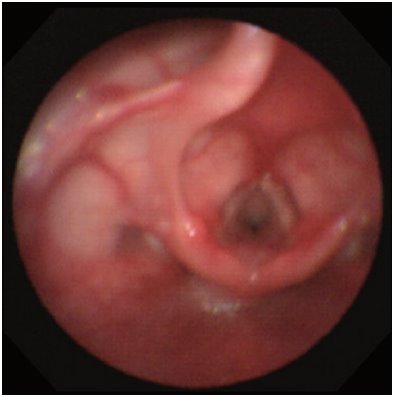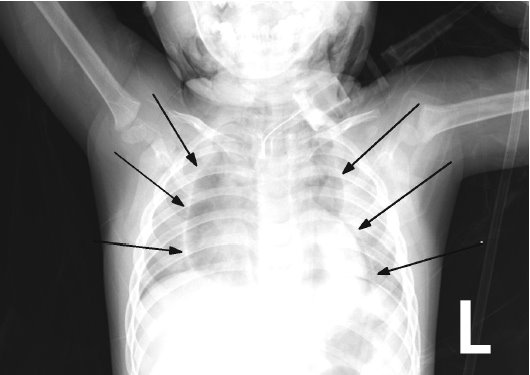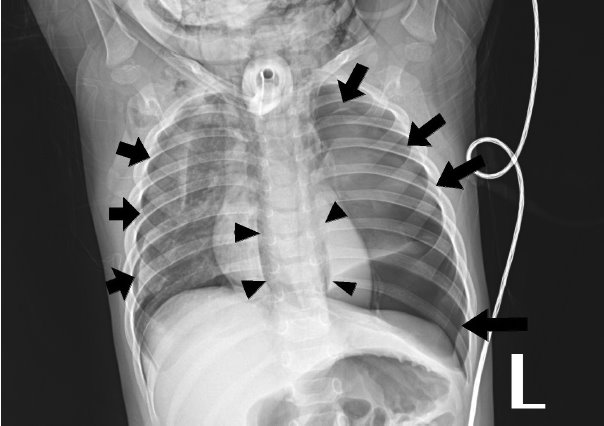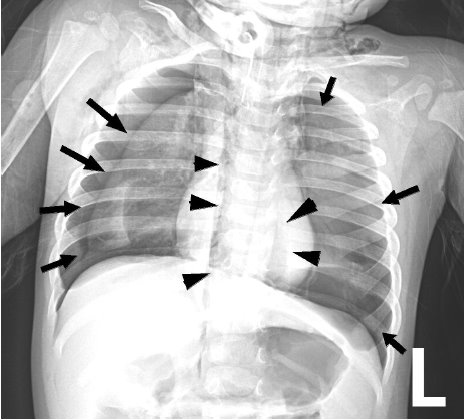Kosin Med J.
2019 Dec;34(2):161-167. 10.7180/kmj.2019.34.2.161.
Iatrogenic Tension Pneumothorax after Surgical Tracheostomy in a Child with Idiopathic Subglottic Stenosis: case report
- Affiliations
-
- 1Department of Anesthesiology and Pain Medicine, Dong-A University College of Medicine, Busan, Korea. surfy07@google.com
- KMID: 2467977
- DOI: http://doi.org/10.7180/kmj.2019.34.2.161
Abstract
- Tracheostomy is increasingly performed in children for upper airway anomalies. Here, an 18-month-old child (height 84.1 cm, weight 12.5 kg) presented to the emergency department with dyspnea, stridor, and chest retraction. However, exploration of the airways using a bronchoscope failed due to subglottic stenosis. Therefore, a surgical tracheostomy was successfully performed with manual mask ventilation. However, pneumomediastinum was found in the postoperative chest radiograph. Although an oxygen saturation of 99% was initially maintained, oxygen saturation levels dropped, due to sudden dyspnea, after 3 hours. A chest radiograph taken at this time revealed a left tension pneumothorax and small right pneumothorax. Despite a needle thoracostomy, the pneumothorax was aggravated, and cardiac arrest occurred. Cardiopulmonary-cerebral resuscitation was performed, but the patient was declared dead 30 minutes later. This study highlights the fatal complications that can occur in children during tracheostomy. Therefore, close monitoring, immediate suspicion, recognition, and aggressive management may avoid fatal outcomes.
MeSH Terms
Figure
Reference
-
1. Watters KF. Tracheostomy in infants and children. Respir Care. 2017; 62:799–825.
Article2. Fitzwater JW, Silva NN, Knight CG, Malvezzi L, Ramos-Irizarry C, Burnweit CA. Management of spontaneous pneumomediastinum in children. J Pediatr Surg. 2015; 50:983–986.
Article3. De la Matta-Martín M, Galán MJ, Gallego J. Pneumomediastinum and pneumothorax during emergency tracheotomy under spontaneous ventilation: Macklin meets Müeller? Rev Esp Anestesiol Reanim. 2016; 63:231–234.
Article4. Gasser CR, Pellaton R, Rochat CP. Pediatric Spontaneous Pneumomediastinum:Narrative Literature Review. Pediatr Emerg Care. 2017; 33:370–374.5. El-Nawawy AA, AI-Halawany AS, Antonios MA, Newegy RG. Prevalence and risk factors of pneumothorax among patients admitted to a pediatric intensive care unit. Indian J Crit Care Med. 2016; 20:453–458.
Article6. Gupta P, Modrykamien A. Fatal case of tension pneumothorax and subcutaneous emphysema after open surgical tracheostomy. J Intensive Care Med. 2014; 29:298–301.
Article7. Shen G, Yin H, Cao Y, Zhang M, Wu J, Jiang X, et al. Percutaneous dilatational tracheostomy versus fibre optic bronchoscopyguided percutaneous dilatational tracheostomy in critically ill patients: a randomized controlled trial. Ir J Med Sci. 2019; 188:675–681.
Article8. Leigh-Smith S, Harris T. Tension pneumothorax – time for a re-think? Emerg Med J. 2005; 22:8–16.9. Teplick SK, Clark RE. Various faces of tension pneumothorax. Postgrad Med. 1974; 56:87–92.
Article10. Laan DV, Vu TD, Thiels CA, Pandian TK, Schiller HJ, Murad MH, et al. Chest wall thickness and decompression failure: A systematic review and meta-analysis comparing anatomic locations in needle thoracostomy. Injury. 2016; 47:797–804.
Article11. Jones R, Hollingsworth J. Tension pneumothoraces not responding to needle thoracentesis. Emerg Med J. 2002; 19:176–177.
- Full Text Links
- Actions
-
Cited
- CITED
-
- Close
- Share
- Similar articles
-
- A Case of Tracheostomy Induced Bilateral Tension Pneumothorax
- Life-threatening tension pneumothorax after unsuccessful tracheostomy tube exchange in a trauma patient - A case report -
- Subglottic Laryngeal Stenosis in Association with Congenital Tracheo-esophageal Fistula: A case report
- Acute Respiratory Failure Derived From Subglottic Stenosis in a Patient with Relapsing Polychondritis
- Microlaryngobronchoscopy Without Tracheostomy in Large Subglottic Cyst Obliterating Airway





